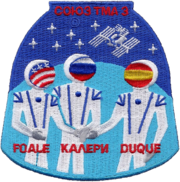Soyuz TMA-3
| Operator | Rosaviakosmos |
|---|---|
| COSPAR ID | 2003-047A |
| Mission duration | 194 days, 18 hours, 33 minutes, 12 seconds |
| Orbits completed | ~3,170 |
| Spacecraft properties | |
| Spacecraft type | Soyuz-TMA 11F732 |
| Manufacturer | RKK Energia |
| Crew | |
| Crew size | 3 |
| Members |
Alexander Kaleri Michael Foale |
| Launching | Pedro Duque |
| Landing | André Kuipers |
| Callsign | Ingul |
| Start of mission | |
| Launch date | October 18, 2003, 05:38:03 UTC |
| Rocket | Soyuz-FG |
| Launch site | Baikonur 1/5 |
| End of mission | |
| Landing date | April 30, 2004, 00:11:15 UTC |
| Landing site | 50.38° N, 67.20° E |
| Orbital parameters | |
| Reference system | Geocentric |
| Regime | Low Earth |
| Perigee | 193 kilometres (120 mi) |
| Apogee | 227 kilometres (141 mi) |
| Inclination | 51.67 degrees |
| Docking with ISS | |

Soyuz programme
(Manned missions) |
|
Soyuz TMA-3 was a Soyuz (Russian Союз ТМА-3, Union TMA-3) mission to the International Space Station (ISS) launched by a Soyuz FG launch vehicle which was the third flight for the TMA modification of the Soyuz spacecraft, and the 7th Soyuz to fly to the ISS.
The commander of the Soyuz was Alexander Kaleri (Russia). The flight engineer was Michael Foale (USA), and Pedro Duque from Spain served as the second flight engineer. After docking with the ISS they exchanged the current crew on ISS and became the eighth station crew, called "ISS Expedition Eight". During the stay on the station Michael Foale was the ISS Commander, while Alexander Kaleri was the engineer. Foale was the first American to have served on both Mir and the ISS. Pedro Duque performed some ESA sponsored science experiments under the mission name Cervantes and then returned with the ISS 7 crew on Soyuz TMA-2.
The backup crew was William McArthur, Valery Tokarev and André Kuipers.
Foale and Kaleri along with André Kuipers, the third seater from TMA-4 landed on April 29, 2004, near Arkalyk, Kazakhstan. A minor helium leak did not affect their mission.
...
Wikipedia

